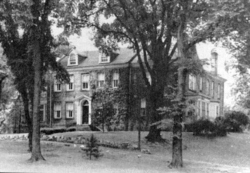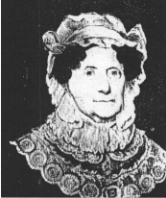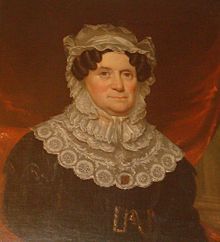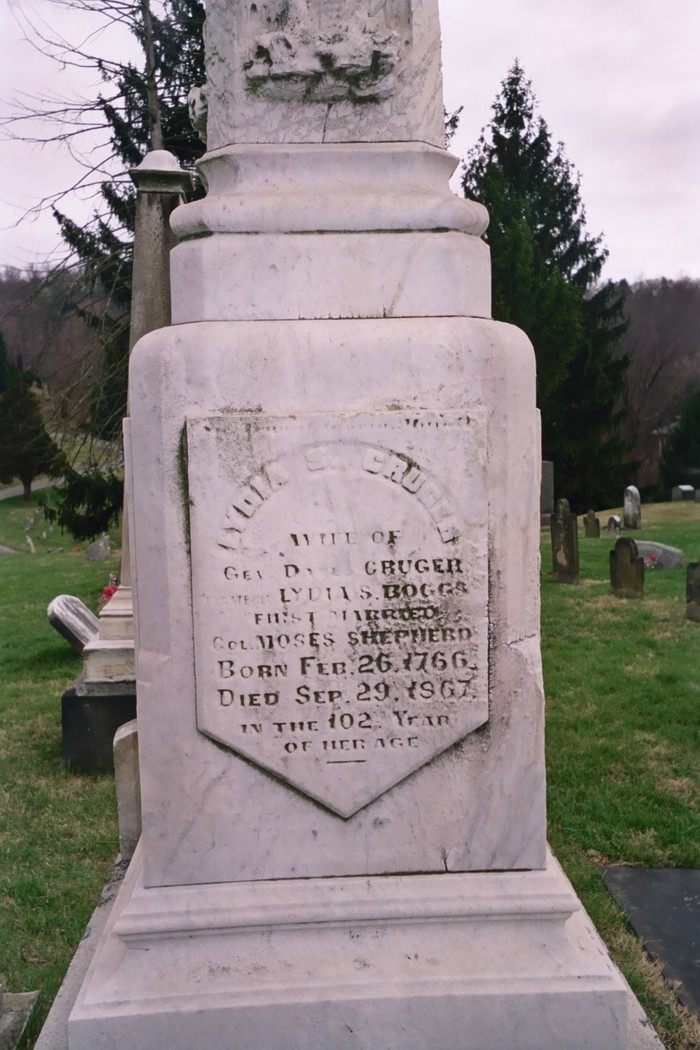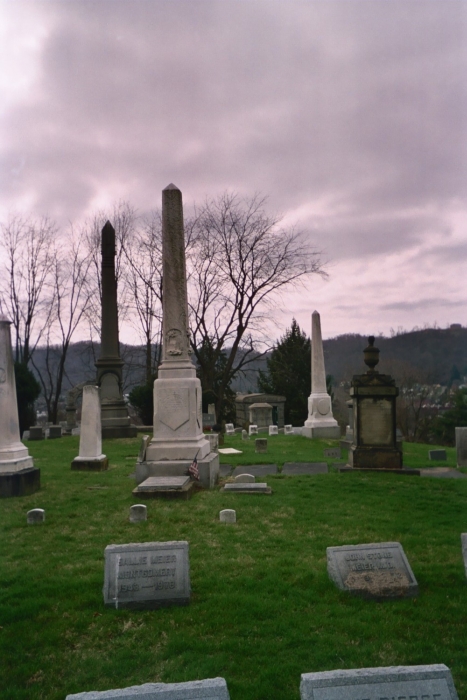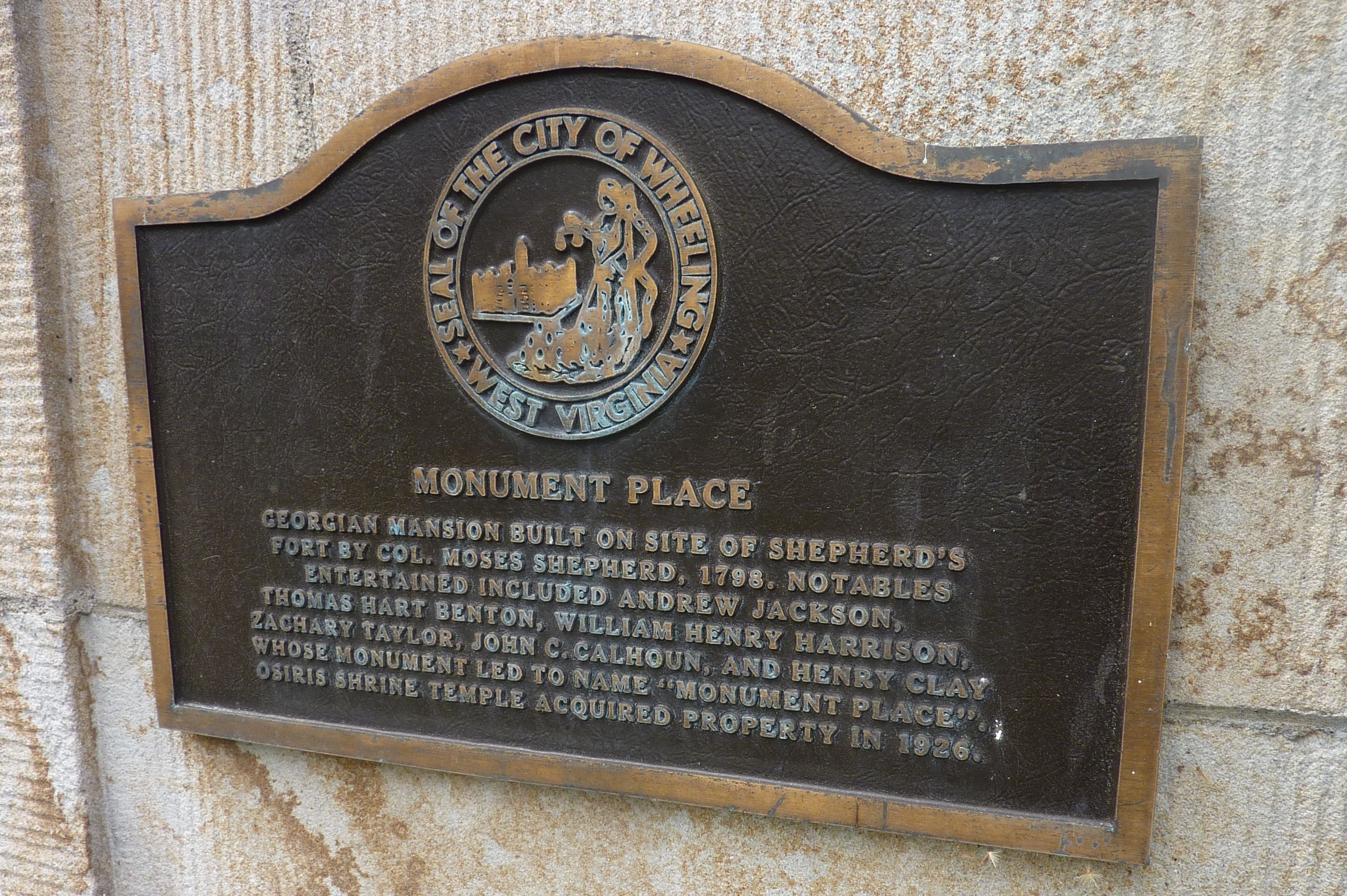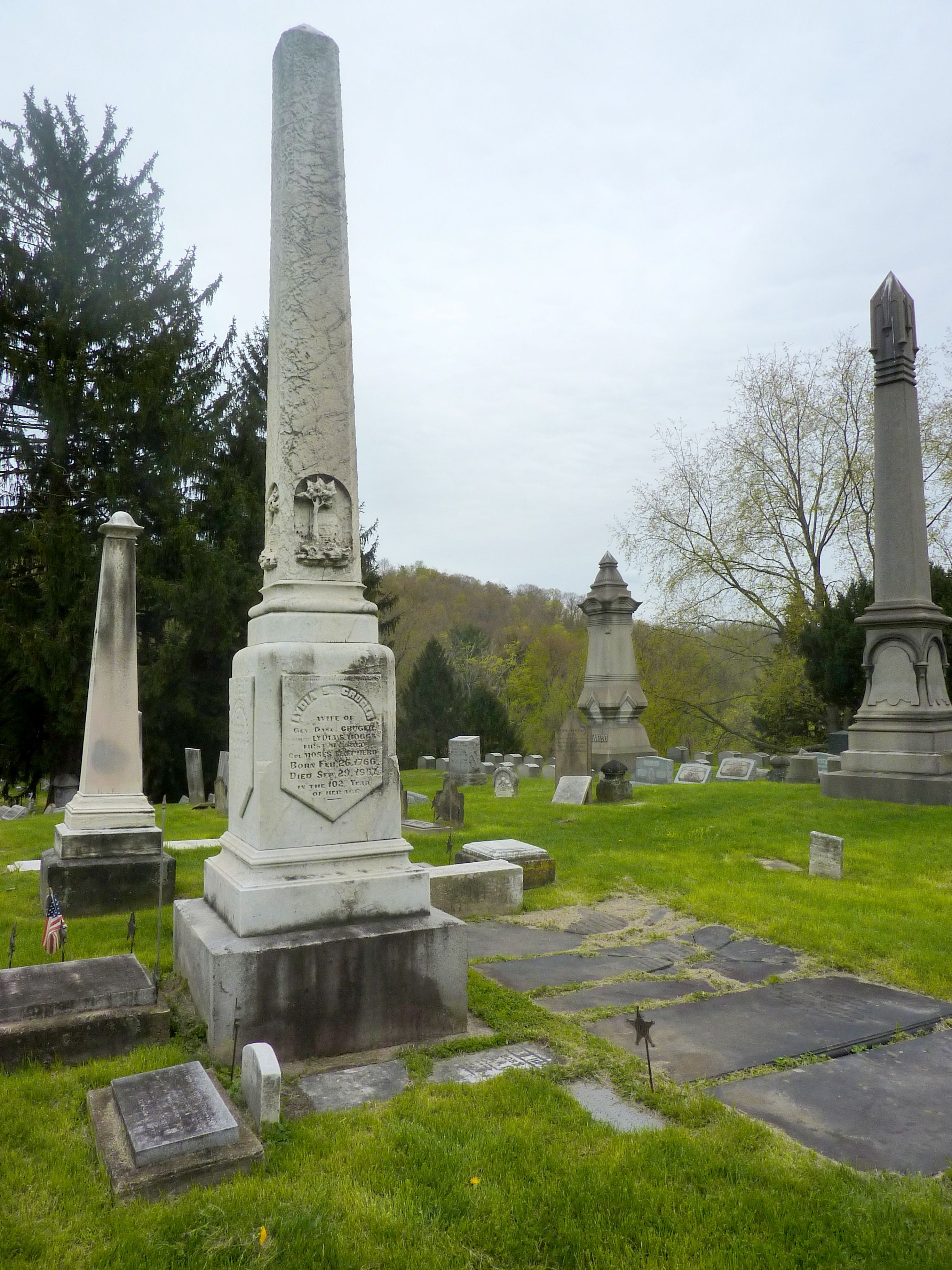She was born in Frederick Co. VA, now Berkeley Co. WV, on Feb 26, 1766, the daughter of Capt. John Boggs and Jean (Jane) Irwin. Her grandfather, William Boggs moved his family from Londonderry, Ireland, to America in 1750, obtained a Fairfax grant of about 1000 acres and built his modest cabin but a short distance from the Warm Springs road running from Martinsburg to Berkeley Springs. There in her grandfathers home she was born. When she was a small child the family moved to Chartiers Creek, Western PA, and in 1774 her father Capt Boggs was stationed at Catfish Camp, now Washington, PA. Capt John Boggs was an intimate friend of Col. David Shepherd, the father of Col. Moses Shepherd, and when Fort Shepherd was beseiged by the Indians Sept 1, 1777, he went to the rescue with forty men, arriving the following morning. He was there to help restore order, to bury the dead, and to prepare for further defense of the Fort. In 1781, Capt Boggs was living on Buffalo Creek, where both he and his daughter were captured by Indians, but soon made their escape. After that they returned to Wheeling because of the very unprotected location of their home.
Moses Shepherd was but seven years of age when Col.David Shepherd moved to the location of Monument Place and there built Fort Shepherd for the protection of the people of the surrounding neighborhood.
Mrs. Cruger was one of the last of the slave owners.
The Last Slave Sale by Mr. John Reynolds, of Ohio Co., W Va Tells an Interesting Little Story (Washington Reporter)
I remember very well the sale of the last Negro in this county "at auction" said John Reynolds, an old resident of Ohio Co., W VA last week. "There was a public sale of the effects of an estate of a man named Higgs, near Wheeling, and among the effects was a good "field hand" a powerful, well-built Negro man. Thomas McConn, Esq. one of the oldest citizens and Magistrates in the State was the auctioneer. The attendance was large, as the sale of Negroes was rather a novelty. Some of the wealthiest and most influential farmers of the county, as well as merchants and business men of Wheeling, were there. The Negro was started at $500 and went up to $800, where he was knocked down to John Goshorn, a merchant of Wheeling and a large land-holder in the county. The Negro was well known, and as he was taken along the National road toward Wheeling hundreds came out to see him and bid him good-by. I had not seen such a sight since the day that old "Hickory Jackson" made his last journey from Washington to Wheeling to take the boat home to Tennessee. The Negro was set to work on a farm near Wheeling, but lived only a few months. There was never another Negro sold in the county for within a short time the war broke out and nearly all of the slave-holders hustled across the line in order to "get out" of the Union. Mrs. Lydia (Boggs) Cruger was the last of the slave-holders. She kept a dozen or fifteen till the proclamation of President Lincoln liberated them. Mrs. Cruger's farm lies four miles east of Wheeling, on the National road and is at present owned and cultivated by Major Loring. She died along in the last of the sixties(1867) at the age of 102 years old. Her first husband, Colonel Sheppard (Moses Shepherd), and her last husband was Colonel Moses Cruger(General Daniel Cruger), were both gentlemen of National fame. The mansion of Mrs. Cruger was the stopping place of Henry Clay, James K. Polk, Andrew Jackson, John C. Calhoun, and many others of National prominence from 1820 to 1860. Henry Clay sent his colored body servant one day ahead of him to call on Mrs. Cruger to notify her of his approach and ask the courtesy of hospitality for one night. The occasion of Mr. Clay's visit was always signalized by a reception to the aristocracy of the county and not a few of the older residents of Wheeling recall with feeling of pleasure the Clay visits to the Cruger's mansion. So great was Mrs. Cruger's admiration of the Kentucky statesman that she had a monument erected in the most prominent corner of her grounds. This corner happened to front on the National road, Clay's own most imperishable monument, and it is pointed out today as the enduring relic of the lady's regard for the great Whig apostle. Mrs. Cruger, as a slave-holder was a model. Of the dozen or fifteen slaves held by Mrs. Cruger, not one of them could complain of his or her condition of involuntary servitude. They did not work, as the old lady persisted in managing her estate herself despite the tokens of senility that forced themselves on her heirs. She had not for many years sold a slave, but frequently bought them. She was often heard to remark that she had seen the rise and fall of the slave system in this country, and she herself was perhaps the only slave-holder who stood by and saw the liberation of her slaves without regret.
She also is associated with the Ft. Henry gunpowder exploit in Sept 1782 with Molly Scott and Betsy Zane.
r The True Wetzelian, Vol V No 2, Issue 26, Mar-Apr 2001, p.2
Lydia’s Monument, Stone Church Cemetery
One of the most notable of Wheeling’s early settlers was Lydia Boggs. Born on February 26, 1766, her life spanned the period from the days when King George III was the reigning monarch of the American Colonies, and on into the presidency of Andrew Johnson. She was a resident of Fort Henry during the Indian Attack of 1781, when her father, Captain John Boggs, was commandant, and again during the Siege of 1782. Because her memory remained sharp well into advanced age, she was able to give Dr. Draper not only a tremendous amount of factual detail concerning early pioneer life, but she also described the fort itself in considerable detail. No other person saw the change from a wilderness frontier settlement to a large American city, as did Lydia. Upon her death on September 29, 1867 (more than two years after President Lincoln’s assassination) she was buried next to her husbands, Moses Shepherd and Gen. Daniel Cruger, in Stone Church Cemetery atop the hill which overlooks Lydia’s Stone Mansion. Visiting her grave site is not difficult: traveling east from Wheeling along U.S. 40, go through the village of Elm Grove (6 miles east of Wheeling) and cross the camel-back bridge (built in 1811 by her husband, Moses Shepherd, as a part of the National Road project). At the stoplight go straight ahead instead of turning left to remain on 40; you will be on Kruger Street, passing Lydia’s Mansion. Go one block, turn left onto Lounez Street, go to the second stop sign, and turn right onto Stone Church Road. Continue on this road, bending around the curve to the right and up the hill. After a couple hundred yards you will see the large entrance gates. Leave your conveyance and enter the cemetery. Walk to the crest of the hill, toward a large evergreen tree, just ahead and slightly to the right, perhaps 75-80 yards. As you approach that tree you will see, to your left, the large white spire that marks the graves of Lydia Boggs Shepherd Cruger (buried to the right of the monument), her first husband, Moses Shepherd (in the center), and her second husband, Gen. Daniel Cruger (to the left). Be sure to take note of the two pioneer scenes carved on the monument.
Unfortunately, two other markers have been placed atop these graves. The one in front of the monument is a common marker for Col. David Shepherd and two of his sons, William & Moses, Lydia’s first husband, while the one to the right is for Francis Duke, the husband of Sarah Shepherd, daughter of Col. Shepherd. The dates given on these markers are: Col. David Shepherd 1734-1795; William Shepherd 1753-1777; Moses Shepherd 1763-1832; Lydia (Boggs) Shepherd Feb 26, 1766 – Sept 29, 1867.
Col. Shepherd’s son William, and his son-in-law, Francis Duke, were both killed during the first siege of Fort Henry, September 1st, 1777. William was killed while attempting to regain the fort; Duke, deputy commissary of Ohio Co., was shot down by Indians as he tried to enter the fort after Mason’s and Ogle’s defeats.
Lydia died at the age of 101; she would have celebrated her 102nd birthday the next February. Her monument (correctly) reads: in the 102nd year of her age.
Please add this information to her memory.
Thank you, Shirley :)
Contributor: Shirley Wadell (47378656) •
She was born in Frederick Co. VA, now Berkeley Co. WV, on Feb 26, 1766, the daughter of Capt. John Boggs and Jean (Jane) Irwin. Her grandfather, William Boggs moved his family from Londonderry, Ireland, to America in 1750, obtained a Fairfax grant of about 1000 acres and built his modest cabin but a short distance from the Warm Springs road running from Martinsburg to Berkeley Springs. There in her grandfathers home she was born. When she was a small child the family moved to Chartiers Creek, Western PA, and in 1774 her father Capt Boggs was stationed at Catfish Camp, now Washington, PA. Capt John Boggs was an intimate friend of Col. David Shepherd, the father of Col. Moses Shepherd, and when Fort Shepherd was beseiged by the Indians Sept 1, 1777, he went to the rescue with forty men, arriving the following morning. He was there to help restore order, to bury the dead, and to prepare for further defense of the Fort. In 1781, Capt Boggs was living on Buffalo Creek, where both he and his daughter were captured by Indians, but soon made their escape. After that they returned to Wheeling because of the very unprotected location of their home.
Moses Shepherd was but seven years of age when Col.David Shepherd moved to the location of Monument Place and there built Fort Shepherd for the protection of the people of the surrounding neighborhood.
Mrs. Cruger was one of the last of the slave owners.
The Last Slave Sale by Mr. John Reynolds, of Ohio Co., W Va Tells an Interesting Little Story (Washington Reporter)
I remember very well the sale of the last Negro in this county "at auction" said John Reynolds, an old resident of Ohio Co., W VA last week. "There was a public sale of the effects of an estate of a man named Higgs, near Wheeling, and among the effects was a good "field hand" a powerful, well-built Negro man. Thomas McConn, Esq. one of the oldest citizens and Magistrates in the State was the auctioneer. The attendance was large, as the sale of Negroes was rather a novelty. Some of the wealthiest and most influential farmers of the county, as well as merchants and business men of Wheeling, were there. The Negro was started at $500 and went up to $800, where he was knocked down to John Goshorn, a merchant of Wheeling and a large land-holder in the county. The Negro was well known, and as he was taken along the National road toward Wheeling hundreds came out to see him and bid him good-by. I had not seen such a sight since the day that old "Hickory Jackson" made his last journey from Washington to Wheeling to take the boat home to Tennessee. The Negro was set to work on a farm near Wheeling, but lived only a few months. There was never another Negro sold in the county for within a short time the war broke out and nearly all of the slave-holders hustled across the line in order to "get out" of the Union. Mrs. Lydia (Boggs) Cruger was the last of the slave-holders. She kept a dozen or fifteen till the proclamation of President Lincoln liberated them. Mrs. Cruger's farm lies four miles east of Wheeling, on the National road and is at present owned and cultivated by Major Loring. She died along in the last of the sixties(1867) at the age of 102 years old. Her first husband, Colonel Sheppard (Moses Shepherd), and her last husband was Colonel Moses Cruger(General Daniel Cruger), were both gentlemen of National fame. The mansion of Mrs. Cruger was the stopping place of Henry Clay, James K. Polk, Andrew Jackson, John C. Calhoun, and many others of National prominence from 1820 to 1860. Henry Clay sent his colored body servant one day ahead of him to call on Mrs. Cruger to notify her of his approach and ask the courtesy of hospitality for one night. The occasion of Mr. Clay's visit was always signalized by a reception to the aristocracy of the county and not a few of the older residents of Wheeling recall with feeling of pleasure the Clay visits to the Cruger's mansion. So great was Mrs. Cruger's admiration of the Kentucky statesman that she had a monument erected in the most prominent corner of her grounds. This corner happened to front on the National road, Clay's own most imperishable monument, and it is pointed out today as the enduring relic of the lady's regard for the great Whig apostle. Mrs. Cruger, as a slave-holder was a model. Of the dozen or fifteen slaves held by Mrs. Cruger, not one of them could complain of his or her condition of involuntary servitude. They did not work, as the old lady persisted in managing her estate herself despite the tokens of senility that forced themselves on her heirs. She had not for many years sold a slave, but frequently bought them. She was often heard to remark that she had seen the rise and fall of the slave system in this country, and she herself was perhaps the only slave-holder who stood by and saw the liberation of her slaves without regret.
She also is associated with the Ft. Henry gunpowder exploit in Sept 1782 with Molly Scott and Betsy Zane.
r The True Wetzelian, Vol V No 2, Issue 26, Mar-Apr 2001, p.2
Lydia’s Monument, Stone Church Cemetery
One of the most notable of Wheeling’s early settlers was Lydia Boggs. Born on February 26, 1766, her life spanned the period from the days when King George III was the reigning monarch of the American Colonies, and on into the presidency of Andrew Johnson. She was a resident of Fort Henry during the Indian Attack of 1781, when her father, Captain John Boggs, was commandant, and again during the Siege of 1782. Because her memory remained sharp well into advanced age, she was able to give Dr. Draper not only a tremendous amount of factual detail concerning early pioneer life, but she also described the fort itself in considerable detail. No other person saw the change from a wilderness frontier settlement to a large American city, as did Lydia. Upon her death on September 29, 1867 (more than two years after President Lincoln’s assassination) she was buried next to her husbands, Moses Shepherd and Gen. Daniel Cruger, in Stone Church Cemetery atop the hill which overlooks Lydia’s Stone Mansion. Visiting her grave site is not difficult: traveling east from Wheeling along U.S. 40, go through the village of Elm Grove (6 miles east of Wheeling) and cross the camel-back bridge (built in 1811 by her husband, Moses Shepherd, as a part of the National Road project). At the stoplight go straight ahead instead of turning left to remain on 40; you will be on Kruger Street, passing Lydia’s Mansion. Go one block, turn left onto Lounez Street, go to the second stop sign, and turn right onto Stone Church Road. Continue on this road, bending around the curve to the right and up the hill. After a couple hundred yards you will see the large entrance gates. Leave your conveyance and enter the cemetery. Walk to the crest of the hill, toward a large evergreen tree, just ahead and slightly to the right, perhaps 75-80 yards. As you approach that tree you will see, to your left, the large white spire that marks the graves of Lydia Boggs Shepherd Cruger (buried to the right of the monument), her first husband, Moses Shepherd (in the center), and her second husband, Gen. Daniel Cruger (to the left). Be sure to take note of the two pioneer scenes carved on the monument.
Unfortunately, two other markers have been placed atop these graves. The one in front of the monument is a common marker for Col. David Shepherd and two of his sons, William & Moses, Lydia’s first husband, while the one to the right is for Francis Duke, the husband of Sarah Shepherd, daughter of Col. Shepherd. The dates given on these markers are: Col. David Shepherd 1734-1795; William Shepherd 1753-1777; Moses Shepherd 1763-1832; Lydia (Boggs) Shepherd Feb 26, 1766 – Sept 29, 1867.
Col. Shepherd’s son William, and his son-in-law, Francis Duke, were both killed during the first siege of Fort Henry, September 1st, 1777. William was killed while attempting to regain the fort; Duke, deputy commissary of Ohio Co., was shot down by Indians as he tried to enter the fort after Mason’s and Ogle’s defeats.
Lydia died at the age of 101; she would have celebrated her 102nd birthday the next February. Her monument (correctly) reads: in the 102nd year of her age.
Please add this information to her memory.
Thank you, Shirley :)
Contributor: Shirley Wadell (47378656) •
Family Members
Advertisement
Advertisement
